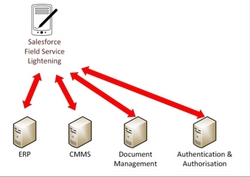3 Strategic Reasons Why Mobile Platforms beat Standalone Apps
Forward thinking industrial services companies are replacing cumbersome manual processes and paperwork with digital solutions. Industrial mobile apps are at the heart of this strategy as they transform productivity across a diverse range of processes such as logistics, field service, time management, warehousing, construction and equipment operations.
Organizations with many thousands of operational users must choose between procuring, configuring and integrating many standalone apps, or implementing their mobile strategy on an enterprise mobile platform such as PHALANX.
This blog introduces three things your organization should consider when evaluating industrial mobile apps.
User Acceptance
 If you are managing a depot logistics workforce and provide app A for returning equipment and recording damages, app B for performing a depot service on equipment and app C to record time spent against each activity, then your users will not thank you for the constant app switching during a typical shift. This is especially true if apps A, B and C are not all certified for use on your target mobile device, leading to an expensive and inconvenient technology toolbelt of various handhelds and tablets.
If you are managing a depot logistics workforce and provide app A for returning equipment and recording damages, app B for performing a depot service on equipment and app C to record time spent against each activity, then your users will not thank you for the constant app switching during a typical shift. This is especially true if apps A, B and C are not all certified for use on your target mobile device, leading to an expensive and inconvenient technology toolbelt of various handhelds and tablets.
Rolling out standalone apps from multiple vendors will also introduce different user experiences that require additional user training. If you are supporting an international operation then you must also consider local language support and the potential for conflicting labels and terms across apps. Return on investment (ROI) can only be achieved if your operations teams use the mobile apps provided.
Cost of Ownership for Standalone Apps
Every standalone app you use will typically have a monthly subscription cost. If you require multiple standalone apps you will have to engage with a range of vendors to meet your needs.
In the depot logistics example above you could, for example, use Rental Essentials for equipment logistics ($25 per user/per month), Salesforce Field Service Lightning for depot servicing ($164 per user/per month with enterprise integration) and Replicon for tracking time to projects ($15 per user/per month)1.
All of these apps are available on the PHALANX Platform at A FRACTION OF THE COST per user/per month. Please contact us to be pleasantly surprised.
| Type of App | Supplier | Cost Per User / Per Month |
|---|---|---|
| Equipment Logistics | Rental Essentials | $25 |
| Field and Depot Service | Salesforce | $164 |
| Time capture and billing | Replicon | $15 |
| Total cost Per User / Per Month | $204 |
There are also the hidden costs of managing multiple point application vendors to be aware of. For example, managing multiple Support and Maintenance processes with varying service level agreements and legal frameworks is an expensive and time consuming internal overhead.
Systems Integration
A truly paperless, seamless digital operation will inevitably require integration to existing core back-end systems. In the example above, the apps would be integrated to multiple modules in the Enterprise Resource Planning (ERP) system (e.g. HR and Projects Modules to track time and allocate to billable contracts, Inventory and Materials to track equipment as it moves between sites etc.)
Other systems that are often deeply integrated into your app ecosystem include:
- Computerized Maintenance Management (CMMS)
- Document Management
- Authentication and Authorization
- Business Intelligence Reporting
- Mobile Device Management systems
Systems integration is one of the highest risk and highest cost activities when configuring an enterprise solution. Using multiple point applications will result in a combinatorial integration explosion as you can see in the diagram below.


When using an integrated mobile software platform there is a single integration point to each back-office system (4 in total for this scenario). Using standalone apps requires 12 integration points, leading to 3 times the complexity and cost.

It is also worth noting that PHALANX has over 13 years’ investment in enterprise integration adaptors including Oracle, SAP, Infor, Microsoft Dynamics, Power BI and Documentum. The combination of pre-existing adaptors and one integration point per back-office system significantly reduces the risk and cost of project implementations on the PHALANX platform when compared with standalone point applications.
Summary
In a large operation, with multiple business units across the globe, there is often ‘bottom up’ pressure to locally implement a favorite app to meet tactical objectives. If this behavior is replicated across the business, then the organisation will be rapidly overwhelmed integrating and deploying standalone mobile apps. This will ultimately result in an expensive change management program to consolidate overlapping functionality to a core set of functionality that is easy to use across an approved range of mobile devices and operating systems.
Spartan recommends a ‘top down’ digital strategy that rapidly delivers customizable apps on an integrated mobile platform. Building on a single platform reduces app license, mobile hardware and system integration costs. Platforms such as PHALANX, also reduce project delivery risk and deliver a cohesive user experience that your end users will thank you for.
1 All prices were valid as of May 2017 based on publicly available information on supplier websites. Prices have been converted from EUR and GBP to USD using www.xe.com

